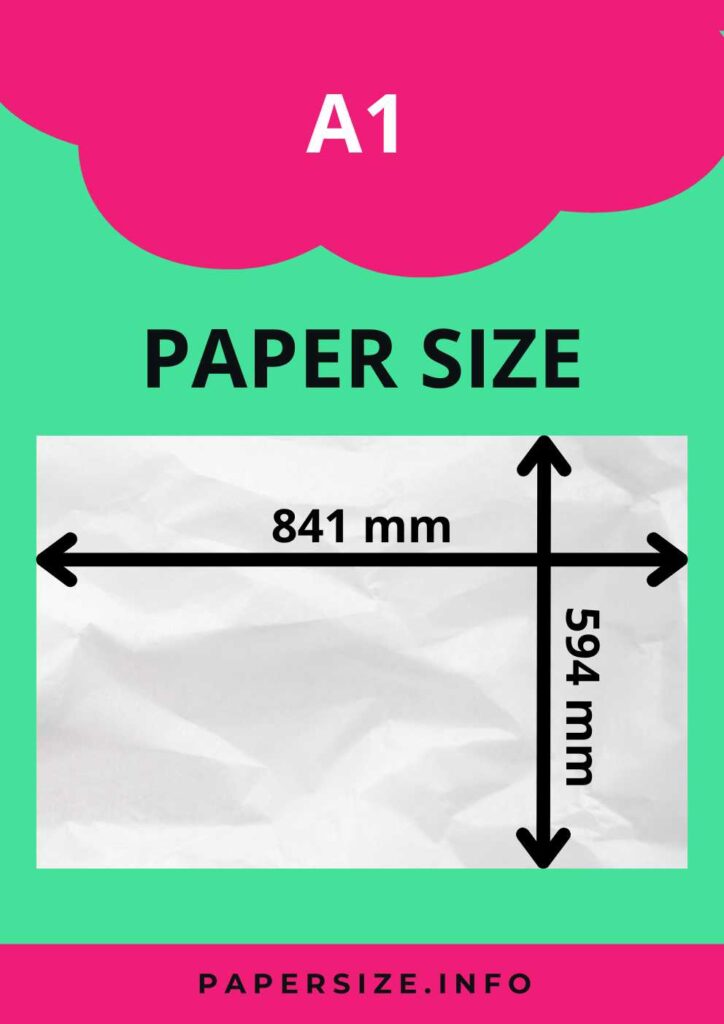A1 Paper Size and Dimensions

A1 paper size, A1 sheet size, A1 paper size in mm, cm, meter, inches and feet. All A1 paper size data in one place.
The A1 paper size is widely recognized and utilized under the ISO standard sizing, prevalent in Europe and nearly globally, with the notable exceptions of North America, certain areas of South America, and the Philippines. As a member of the A series of paper sizes, A1 is integral to a system designed to simplify paper size standardization internationally.
Comprehensive Dimensions of A1 Paper Size
- Millimeters: 594 x 841 mm
- Centimeters: 59.4 x 84.1 cm
- Meters: 0.594 x 0.841 m
- Inches: 23.4 x 33.1 inches
- Feet: 1.95 x 2.75 feet
This size is particularly favored for technical drawings, flip charts, and posters, where ample space is required to display information clearly and visibly. The dimensions of A1 make it especially suitable for applications that demand space for detail without becoming unwieldy.
The use of A1 paper is a testament to the effectiveness of the ISO 216 standard, which was designed to have each size in the series be half the size of the previous one when folded parallel to its shorter sides. This aspect of the A series not only makes scaling between sizes seamless but also ensures that enlargements and reductions can be made easily without losing the aspect ratio or content integrity.
Globally, the adoption of A1 and other A series sizes facilitates consistency in printing and photocopying standards across different countries and industries. This uniformity is crucial for international businesses and educational sectors that rely on standardized dimensions to ensure compatibility with various equipment and presentation techniques.
For professionals and students around the world, having all the essential data about A1 paper size in one place helps in planning and executing projects that require international cooperation and materials compliance. This consolidation of information promotes efficiency and ease of access to necessary specifications, thereby enhancing productivity and reducing confusion in professional and academic settings.
Area of A1 Paper
A1 paper is directly derived from the A0 size, being exactly half its area. This results in the A1 size having:
- Square Meters: 0.5 sq m
- Square Inches: 774.3102 sq in
- Square Feet: 5.3772 sq ft
This method of defining paper sizes by area makes it straightforward to understand the scaling and size relationships within the A series. For example, each subsequent size in the series (e.g., A2, A3) is half the area of its predecessor, which simplifies resizing and scaling down documents while maintaining the content’s aspect ratio accurately.
Understanding the area of A1 paper is particularly useful in fields such as graphic design, architecture, and engineering, where large format papers are commonly used for detailed plans and layouts. The consistent ratio and predefined area help professionals predict the amount of space they have to work with, ensuring that designs are properly scaled and printed according to precise specifications.
Moreover, this system aids in resource planning and cost estimation for printing projects, as paper size directly influences material requirements and expenses. By knowing the exact area of the paper, individuals and businesses can better manage their supplies and budget for printing and distribution needs effectively.
A1 Paper Size in Pixels
The conversion of A1 paper size to pixels is a common query that arises when one aims to print a design onto an A1 sheet and wants to ensure the design maintains perfect resolution. However, the translation from physical dimensions to pixels isn’t straightforward as it heavily depends on the resolution, measured in dots per inch (DPI), of the printing device or display.
Understanding DPI and Its Impact:
DPI stands for “dots per inch,” a measure of how many pixels will be printed or displayed per inch. The native screen resolution varies significantly across devices:
- Monitors: Commonly believed to be around 72 DPI, but more typically range between 100 and 120 DPI.
- Home or Office Printers: Usually operate at about 300 DPI.
- Professional Printing Services: Can vary between 250 DPI to 600 DPI, though some professional printers may even go up to 1200 DPI for extremely high-quality outputs.
Pixel Dimensions for A1 Size:
Given these variances in resolution, here are the approximate pixel dimensions for an A1 sheet at different DPI settings:
- 96 DPI: 3179 x 2245 pixels
- 100 DPI: 3311 x 2339 pixels
- 120 DPI: 3973 x 2806 pixels
- 300 DPI: 9933 x 7016 pixels
- 600 DPI: 19866 x 14031 pixels
Importance of Choosing the Right DPI:
When planning to print a design, it’s crucial to know the specific DPI setting of your printer or display to ensure that the final output matches your expectations. Selecting the appropriate DPI is essential for achieving the desired clarity and detail in the printed design. For instance, a higher DPI setting will result in a sharper and more detailed image but will require a file with more pixels, which increases the file size and may impact printing speeds and costs.
Practical Considerations:
Before starting a design project intended for A1 printing, verify the DPI settings of your intended printing service or device. This will allow you to create a design with the optimal number of pixels, ensuring that the dimensions of your digital image will perfectly match the physical size of the A1 paper, thus avoiding any issues with image stretch or pixelation.
Understanding these details about pixel dimensions relative to DPI settings is pivotal for anyone involved in graphic design, digital printing, or any field where precise visual reproduction is necessary. This knowledge ensures that designs are created with the necessary specifications for high-quality outcomes.

